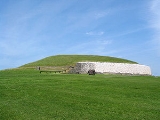finicky
The alphabet is widely considered to have been 'invented' once [cf, Diringer, The Alphabet: A Key to the History of Mankind (1968: third edition) vol 1, p145]. Theories of its origin remain varied and inconclusive. In 1995 I discovered that several letters of the alphabet correspond in their positions within the alphabetic sequence, to phases of the moon in the lunar sequence.
The lunar cycle begins with two nights of darkness, when no lunar phase is visible in the sky. The first letter of the alphabet 'A' when laid on its side (as in the earliest alphabetic inscriptions) resembles a vertex, or sighting scope, with a cross-stroke through it - arguably signifying 'nothing visible'.
The second letter 'B' resembles a doubled vertex with a cross-stroke through it - signifying 'nothing visible' on the second night.
The third letter 'C' resembles the crescent moon - which appears on the third night of the lunar sequence.
The waxing half-moon which occurs on the ninth night of the lunar sequence is figured in the eighth letter of the early alphabet, 'Θ' theta (or teth in the Hebrew alphabet) - constructed as a circle bisected by its diameter.
The first full moon occurs on the fifteenth night of the lunar sequence. The fifteenth letter is 'O' (omicron, ayin).
Few people realize that there appear to be two nights of full moon in every lunar cycle. The sixteenth letter, 'Π' pi (pe in the Hebrew alphabet), outlines the square constructed on the diameter of the full moon - a 'squared' circle to distinguish it from the first full moon. The square was appropriate because the number 16 embodies a perfect square whose area equals its perimeter (4 x 4 = 4 + 4 + 4 + 4). Which is why 'pi' continues to represent the relation of diameter to circumference, in mathematics.
Night 17 ushered in the first waning phase of the cycle, a sad harbinger of decay for the ancient observer. Letter 17, our 'Q' (ancient qoph or kaph), depicts a full moon trailing a telltale descender - figuring downfall.
And letter 22, 'X' chi, presents an image of crossed diameters, reflecting the waning half-moon on night 23 (the 45-degree waxing oblique cancelled by the 315-degree waning oblique).
The alphabet, in other words, appears to have been conceived as a mnemonic of lunar cycle.
Those interested in further details will find nine abstracts and a video seminar available for free viewing at http://www.archive.org/search.php?query=drumbolis&sort=-downloads .
I've issued five books on the subject:
God's Wand: The Origin of the Alphabet (2001);
Shrouded in Scripture (2004);
God's Shadow: A Chronological Supplement of Sample Figures Illustrating a Continuous Tradition of Covert Lunar Notation (2004);
Myth as Math: Calendrical Significance in the Mosaic Census of the Sons of Israel (2007);
Instructions for Restoring the Ancient Wisdom: A Primer of the Pythagorean Practicum (2009) - a succinct guide which may be found among the abstracts on-line.
Nick Drumbolis in Toronto
NOTE: as posted initially at NAKED SCIENTISTS (31 October 2010) where an earlier discussion of this theory may be reviewed under the title NEW ALPHABET THEORY [http://www.thenakedscientists.com/forum/index.php?board=18.0]
The lunar cycle begins with two nights of darkness, when no lunar phase is visible in the sky. The first letter of the alphabet 'A' when laid on its side (as in the earliest alphabetic inscriptions) resembles a vertex, or sighting scope, with a cross-stroke through it - arguably signifying 'nothing visible'.
The second letter 'B' resembles a doubled vertex with a cross-stroke through it - signifying 'nothing visible' on the second night.
The third letter 'C' resembles the crescent moon - which appears on the third night of the lunar sequence.
The waxing half-moon which occurs on the ninth night of the lunar sequence is figured in the eighth letter of the early alphabet, 'Θ' theta (or teth in the Hebrew alphabet) - constructed as a circle bisected by its diameter.
The first full moon occurs on the fifteenth night of the lunar sequence. The fifteenth letter is 'O' (omicron, ayin).
Few people realize that there appear to be two nights of full moon in every lunar cycle. The sixteenth letter, 'Π' pi (pe in the Hebrew alphabet), outlines the square constructed on the diameter of the full moon - a 'squared' circle to distinguish it from the first full moon. The square was appropriate because the number 16 embodies a perfect square whose area equals its perimeter (4 x 4 = 4 + 4 + 4 + 4). Which is why 'pi' continues to represent the relation of diameter to circumference, in mathematics.
Night 17 ushered in the first waning phase of the cycle, a sad harbinger of decay for the ancient observer. Letter 17, our 'Q' (ancient qoph or kaph), depicts a full moon trailing a telltale descender - figuring downfall.
And letter 22, 'X' chi, presents an image of crossed diameters, reflecting the waning half-moon on night 23 (the 45-degree waxing oblique cancelled by the 315-degree waning oblique).
The alphabet, in other words, appears to have been conceived as a mnemonic of lunar cycle.
Those interested in further details will find nine abstracts and a video seminar available for free viewing at http://www.archive.org/search.php?query=drumbolis&sort=-downloads .
I've issued five books on the subject:
God's Wand: The Origin of the Alphabet (2001);
Shrouded in Scripture (2004);
God's Shadow: A Chronological Supplement of Sample Figures Illustrating a Continuous Tradition of Covert Lunar Notation (2004);
Myth as Math: Calendrical Significance in the Mosaic Census of the Sons of Israel (2007);
Instructions for Restoring the Ancient Wisdom: A Primer of the Pythagorean Practicum (2009) - a succinct guide which may be found among the abstracts on-line.
Nick Drumbolis in Toronto
NOTE: as posted initially at NAKED SCIENTISTS (31 October 2010) where an earlier discussion of this theory may be reviewed under the title NEW ALPHABET THEORY [http://www.thenakedscientists.com/forum/index.php?board=18.0]


